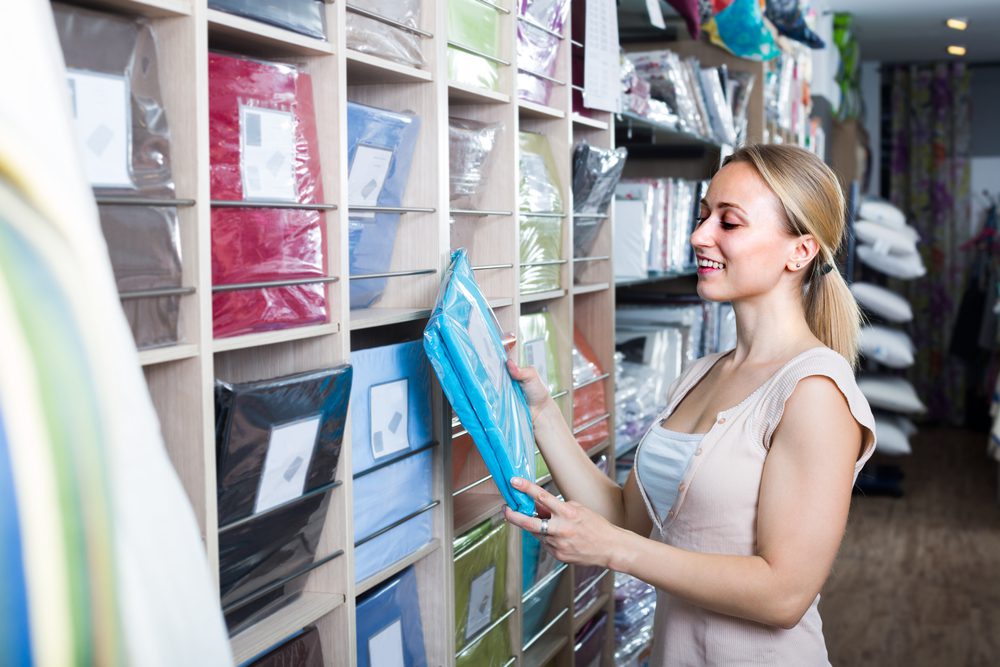While your mattress creates the foundation for rejuvenating rest, your sheets also play an important role.
A quality set of clean sheets can make your bed more comfortable and add decorative flair to your bedroom. They can also help with temperature regulation, keeping you cozy in the winter and cool in the summer.
We’ll walk you through the entire buying process from sizing and color options to environmental certifications. We’ll also address the most common sheet dilemmas, including deciphering thread counts and types of weaves.
You Want New Sheets: Where Do You Start?
Your old sheets look worn, and you’re thinking of buying a new set. There are several different elements of your bedroom and lifestyle that you’ll need to consider before making your purchase.
Choose the Right Size Sheets for Your Bed
Whether you have a twin, a California king, or something in between, it’s important to purchase sheets in the same size as your mattress. This ensures that the length and width of the sheets match your bed.
In addition to your general mattress size, you’ll also need to determine your mattress thickness. Standard sheets accommodate most models, but those over 14 inches thick typically require deep pocket sheets. Mattresses over 16 inches thick may need extra deep pocket sheets.
If you don’t know the profile of your mattress, you can usually find it in the description on the manufacturer’s website. You can also use a tape measure, a ruler, or a measurement app on your smartphone to determine the thickness.
Get an Idea of Your Ideal Thread Count
Thread count tells you how many threads are in 1 square inch of fabric. While a higher thread count sometimes indicates softer sheets, it isn’t the only measure of quality. In fact, some manufacturers disguise lower-quality sheets by inflating the thread count through a manufacturing trick, such as using double- or triple-ply threads to get a higher thread count without necessarily improving the quality of the sheets.
The ideal thread count depends on the type of material and its specific weave. For example, linen sheets use thicker threads. As a result, even high-quality linen tends to have a lower thread count than other common materials, such as cotton. Similarly, the sateen weave is tighter than many alternatives, leading to higher average thread counts.
Pick Sheets to Match Your Seasonal Needs
Choosing the best sheets for your bed also depends on your seasonal needs. If you live in a climate with distinct seasons, you may prefer to have multiple sets. Lightweight sheets can help you stay cool in the summer, while more insulating sheets may keep you warmer in the winter.
Breathability Is Crucial
The optimal sleep environment has a consistent temperature that’s neither too hot nor too cold. The right sheets help regulate the warmth of the sleep surface, thereby impacting your overall comfort and sleep quality. Regardless of your climate, breathable materials allow your body heat to dissipate, limiting extreme temperature fluctuations.
Cotton: Cotton is a highly versatile material for bedding. Depending on the weave, cotton works well in hot or cold weather. For example, cotton sheets with a percale weave are crisp and breathable, making them ideal for warm seasons and hot sleepers. Cotton sheets with a sateen weave are a bit thicker and warmer, so they’re popular for winter use.
Flannel: Flannel can be made from wool, cotton, or polyester. It has a soft, fuzzy texture that helps insulate your body while still letting air circulate. Because of their cozy feel, sleepers often prefer flannel sheets for colder months.
Linen: Made from the fibers of the flax plant, linen is naturally durable and breathable. It is a classic choice for hot and humid summers, but it can also work well for multi-season use in milder climates.
Types of Sheets
The material and weave of your sheets affect their overall performance, including softness, weight, and durability.
Cotton
Made from the fiber of the cotton plant, cotton sheets are typically soft, breathable, and durable. Cotton is a staple fiber that grows in different lengths. As a result, you may see cotton sheets labeled as short-, long-, or extra-long staple. Egyptian cotton, known for its softness and durability, is an extra-long staple variety. True Egyptian cotton is harvested by hand and quite expensive. Affordable sheets that claim to be Egyptian cotton are often mislabeled or contain blends.
Linen
Linen comes from the natural fibers of the flax plant. Linen sheets are incredibly breathable and moisture-wicking, making them one of the best options for warmer weather. Sheets made from linen typically have a crisp or slightly rough feel. However, the material becomes noticeably softer over time.
Polyester & Microfiber
Many sheets on the market today use synthetic materials, such as polyester and microfiber. Synthetic sheets are often more affordable than natural textiles without sacrificing performance. For example, microfiber is generally budget-friendly and incredibly soft.
Bamboo
Sheets labeled as “bamboo” usually consist of rayon, viscose, or lyocell made from cellulose derived from bamboo. The resulting fabric is usually lightweight, breathable, and moisture-wicking, making it appropriate for hot sleepers.
Silk
Silk is a natural material woven from the cocoons of silkworms. Usually considered a luxury option, silk sheets are lightweight and very smooth. Silk is excellent for temperature regulation, allowing you to stay cool in summer and warm in winter. However, silk sheets require more delicate care and can be expensive.
Flannel
Flannel is a soft fabric with a fuzzy texture that is well suited for the fall and winter months. Traditionally made with wool, today you can find affordable flannel sheets made from cotton or synthetic fibers.
Sheet Weaves
Another important feature of sheet fabric is the weave. Weave refers to how the threads are interlaced. Like the type of material, the weave can impact the look, feel, and performance of a sheet set.
Percale
Percale sheets feature a tight weave that follows a simple one yarn under, one yarn over or criss-cross pattern. The result is a highly durable fabric that stays cool. This type of sheet is usually made with cotton, but it can also contain synthetic materials, rayon, or blends.
Sateen
Sateen sheets use a one yarn under, three or four yarns over pattern. This creates a heavier, buttery-soft sheet that is good for colder climates and cold sleepers. However, sheets made from this material are also breathable enough for summer use. Sateen sheets usually have a smooth, lustrous appearance and good drape. Like percale, sateen sheets can be made from a range of different materials, including cotton, synthetic fibers, and rayon.
Jersey
Technically not a weave, jersey is a knit that uses a plain stitch pattern. Many sleepers enjoy jersey sheets for their warmth, softness, and affordability. Most jersey sheets consist of cotton or synthetic fibers. They generally feel like a broken-in t-shirt.
Match Your Sheets to Your Bedroom Decor
How your sheets feel is crucial, but the way they look is also important. If your sheets don’t match the rest of your bedroom decor, you may be less likely to use them.
Do You Want Prints, Patterns, or Solid Colors?
The most important aesthetic decision is whether you want printed, patterned, or solid sheets.
For example, if your bedroom walls are covered in wallpaper or detailed artwork, you may want to choose a solid color for your sheets. However, if your bed is the primary centerpiece of the room, printed or patterned sheets can liven up the space.
When choosing solid sheets, also think about your color choice. Darker colors are less likely to show discoloration, but they may fade over time. White sheets show discoloration, but they can often be bleached to restore a like-new appearance.
Go a Step Further and Add Accessories to Your Sheets
Your sheets are just one dimension of your bedding set. You can get creative by incorporating other accessories. Decorative pillows, throw blankets, or a comforter can broaden the color palette, add texture, and enhance the visual appeal of your bedroom.
Should You Buy Sheets as a Set or as Individual Pieces?
When shopping for new sheets, you may notice that you can buy pieces individually or as a set. There are advantages and disadvantages to each purchasing option.
Sheet Set vs. Individual Pieces
Sheet Options | As a Set | Individual Pieces |
|---|---|---|
Pros |
|
|
Cons |
|
|
Choose Environmentally Friendly Options for Your Next Set of Sheets
Many shoppers are interested in eco-friendly sheet options that help reduce the environmental impact of the purchase. If your skin is sensitive to certain chemicals, you might also be in the market for a more natural option.
However, sometimes it’s difficult to unravel the true claims from marketing jargon.
Look For These Certifications
Companies that market their bedding as environmentally friendly often use buzzwords like “natural,” “organic,” and “sustainable.” While some products earn these distinctions, it can be difficult to know for sure at first glance. Third-party certifications include independent verification to ensure that the manufacturer meets set standards for materials, sourcing, and manufacturing.
OEKO-TEX
The OEKO-TEX Standard 100 certification is available for textiles, including bed sheets. Sheets with the OEKO-TEX Standard 100 label undergo independent lab testing for potentially harmful substances in each component, including the material, stitching, and any coating.
Global Organic Textile Standard (GOTS)
The GOTS label is the leading organic certification for natural textiles, such as cotton and wool. To receive a GOTS certification, an accredited third party must evaluate the entire textile supply chain. Only products that meet the long list of ecological and social standards receive GOTS certification.
Ask the Sleep Doctor
Have questions about sleep? Submit them here! We use your questions to help us decide topics for future articles, videos, and newsletters. We try to answer as many questions as possible. You can also send us an email. Please note, we cannot provide specific medical advice, and always recommend you contact your doctor for any medical matters.







